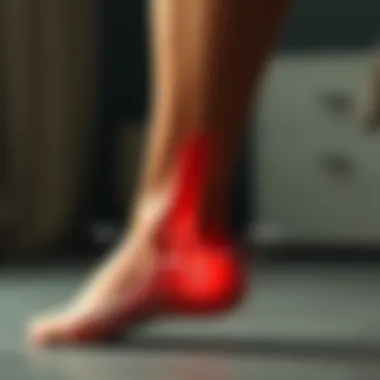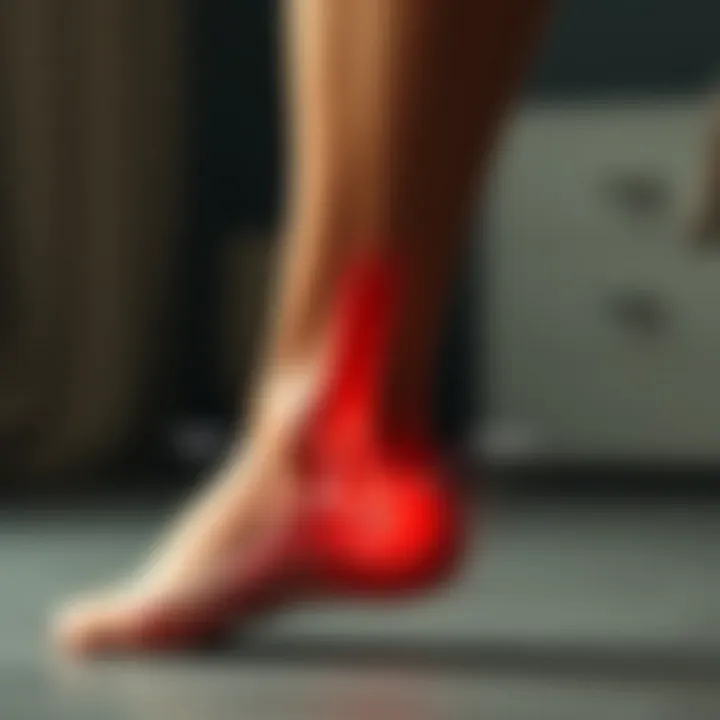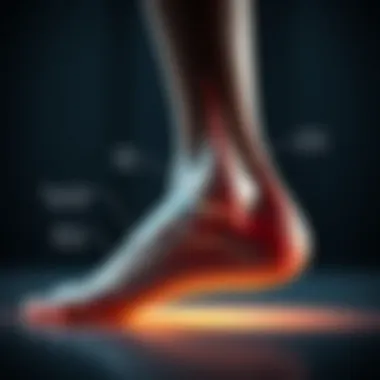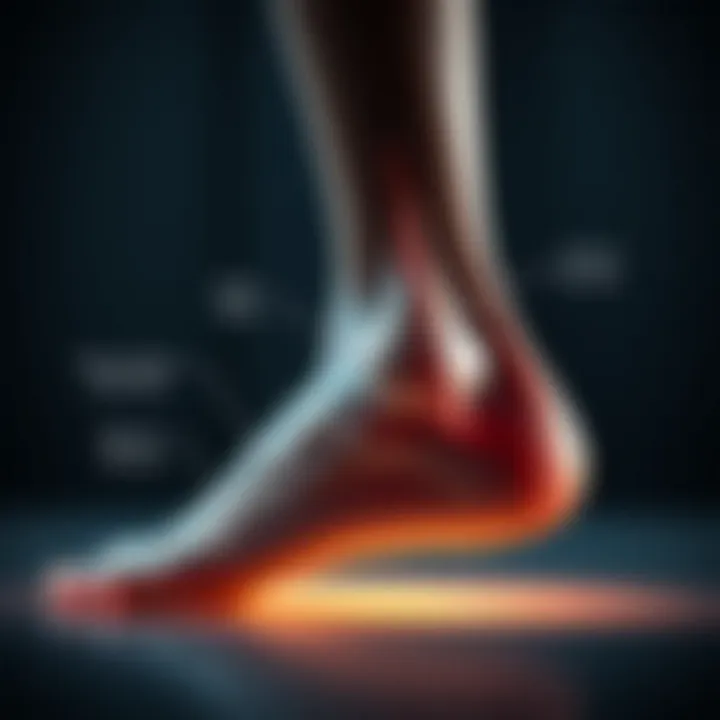Understanding Causes of Ankle Swelling and Risks


Intro
Swelling around the ankles, commonly referred to as peripheral edema, can be a nagging nuisance. It often raises concerns about one’s health, as the reasons behind this condition can range from the mundane to the serious. Underneath the surface, both physiological and environmental factors are at play. Why do some people experience this discomfort while others hardly notice it? This article will embark on a detailed exploration, providing insight into various causes, risk factors, and complications tied to ankle swelling.
Understanding this condition is crucial for maintaining not only physical well-being but also emotional health. It is not just about having swollen ankles; it reflects broader health issues that could require attention. As we delve into the core of this topic, we will highlight everyday practices that can help mitigate symptoms and draw attention to the importance of recognizing when medical intervention is needed.
Health Benefits
Physical Health Benefits
An important aspect of managing swelling around the ankles is acknowledging how certain lifestyle choices can influence physical health. Engaging in regular movement is key. While it might sound basic, the simple act of moving can stimulate circulation, which in turn can help reduce swelling. Take, for instance, walking or cycling, which are low-impact activities that gently work those leg muscles without unnecessary strain. Strengthening the muscles in the lower extremities can also provide better support to the circulatory system, ultimately reducing the likelihood of edema.
- Hydration: Staying adequately hydrated helps maintain fluid balance within the body. Aim for 8-10 glasses of water a day. Think about a time you felt sluggish after not drinking enough water. The body can hold onto fluids more when it is running low, leading to swelling.
- Compression Garments: Use of compression socks or sleeves can help improve blood flow and reduce swelling. They apply gentle pressure, thereby assisting your veins in moving blood back up toward the heart.
Mental Health Benefits
The psychological toll of dealing with persistent ankle swelling shouldn't be overlooked. Not only does it impact physical activity levels, but it can also affect mood and overall mental well-being. Swollen ankles can foster feelings of unease or frustration, especially if they lead to reduced mobility. By being proactive and managing the swelling, you're not just targeting the physical symptoms—you're also addressing mental health needs.
- Optimized Self-Image: Feeling good about one's body often ties directly to mobility. When you take steps towards managing your ankle swelling, it could offer a boost in confidence.
- Mindfulness Practices: Participating in activities that promote mindfulness, like yoga or tai chi, can enhance both physical stability and mental clarity. Becoming more aware of one’s body encourages a sense of control over one’s health.
Engaging in consistent physical activity and hydration plays significant roles in alleviating swelling. Don't underestimate the power of movement!
Practical Tips
Healthy Eating Guidelines
Diet also plays a crucial role in managing ankle swelling. Consuming a balanced diet can ensure that your body receives an adequate supply of nutrients that can combat inflammation.
Here are some dietary recommendations:
- Reduce Sodium Intake: Excess salt can cause your body to retain water, leading to greater swelling. Focus on fresh ingredients rather than processed foods.
- Increase Potassium-Rich Foods: Foods like bananas, spinach, and sweet potatoes can help regulate fluid balance. They might just be the superheroes your body needs.
- Omega-3 Fatty Acids: Including fatty fish such as salmon or chia seeds can reduce inflammation.
Effective Workout Routines
Exercise routines should specifically target the lower body. Here are some exercises to consider:
- Leg Raises: Lying down, lift your legs straight up towards the ceiling and hold for a moment before bringing them down. This promotes circulation.
- Ankle Pumps: While seated, flex and point your toes several times. It might seem simple, but this action significantly aids vascular health.
- Walking: Aim for at least 30 minutes daily. It helps boost circulation and manage body weight, both essential in combating swelling.
In essence, understanding the nuances of swelling around the ankles invites a more extensive exploration of health, fitness, and overall discipline. Ponder the lifestyle adjustments discussed throughout this article—they have the potential to lead toward a healthier future.
For more information, consider visiting resources like medlineplus.gov, healthline.com or mayoclinic.org. The insights provided here can illuminate pathways to achieving optimal health.
Defining Ankle Swelling
Understanding the concept of ankle swelling is pivotal for grasping the broader implications of peripheral edema. This condition, commonly referred to as swelling in the ankles, can signal not just benign causes but potentially serious health concerns as well. Addressing ankle swelling in this article allows for a more comprehensive exploration of how physiological factors, lifestyle choices, and medical conditions intertwine to manifest in this common symptom.
Peripheral edema, as we'll discover, often serves as a body's response to a variety of stimuli. This highlights the need for awareness of the underlying causes that lead to such fluid retention. Recognizing it early can lead to timely interventions, improving long-term health outcomes.
What is Peripheral Edema?
Peripheral edema is the medical term for swelling that occurs in the lower extremities, notably the ankles, feet, and legs. It arises when excess fluid accumulates in the tissues due to an imbalance between the forces pushing fluid into the spaces around cells and those that pull it back into the bloodstream. Various factors can disrupt this balance, leading to swelling and discomfort.
To break it down further:
- Blood flow issues: Sometimes, veins struggle to return blood to the heart effectively, causing fluid to pool.
- Capillary permeability: Increased pressure within capillaries can lead to leakage of fluid.
- Lymphatic system efficiency: If the lymphatic system does not adequately remove excess fluid, swelling can occur.
As fluid buildup can occur due to several reasons, recognizing interplay of these factors enhances our understanding of how peripheral edema can manifest in various forms and how it often acts as an indicator of the body’s unheard story.
Symptoms and Signs to Observe


Detecting ankle swelling goes beyond just noting the visible puffiness. Several signs can indicate the presence of peripheral edema, and understanding these can help in determining the underlying causes. Key symptoms include:
- Swelling in one or both ankles: While bilateral swelling can signal general issues, unilateral swelling might suggest localized problems like injuries or deep vein thrombosis.
- Increased firmness or tightness in the skin: This can be an unsettling feeling, hinting at the inflamed state of the tissues.
- Changes in skin tone or texture: It's worth noting any redness or discoloration, which can be a sign of vascular issues or infection.
- Pain or discomfort: Accompanied swelling may heighten discomfort, altering one’s mobility or daily activities.
Monitoring these symptoms provides critical insights into the nature of the swelling.
"Swelling is not just a symptom; it's a message from the body, inviting scrutiny and attention."
By remaining observant and understanding the significance of these indicators, individuals can make informed choices about when to seek medical advice, fostering a proactive approach to health.
Physiological Mechanisms Behind Swelling
Understanding the physiological mechanisms that contribute to swelling in the ankles is essential for comprehending the broader context of peripheral edema. This section delves into specific factors that cause fluid accumulation in the lower extremities. Knowing these mechanisms not only aids healthcare professionals and wellness coaches in diagnosing issues but also empowers individuals to be proactive in managing their health.
Fluid Retention Explained
Fluid retention, or edema, can occur when the body holds onto excess fluid. This isn't merely a cosmetic issue; several underlying processes might be at play.
- Vascular Permeability: The walls of blood vessels must allow fluids to pass in and out. When they become excessively permeable due to factors such as inflammation or injury, fluid leaks into surrounding tissues, resulting in swelling.
- Lymphatic System Dysfunction: The lymphatic system is tasked with clearing excess fluid and waste from tissues. If it’s not functioning properly—say, due to a blockage or surgical removal of lymph nodes—this fluid can accumulate, leading to noticeable edema.
- Hormonal Influences: Hormones can have a profound impact on fluid retention. For example, aldosterone, a hormone produced by the adrenal glands, encourages the body to retain sodium and water. Conditions that lead to hormonal imbalances may thus lead to increased fluid retention.
Fluid retention can flag more serious health concerns, particularly if it’s chronic, so understanding these mechanisms is vital.
Impact of Gravity
Gravity plays a surprisingly substantial role in ankle swelling, yet it’s often overlooked in discussions about peripheral edema. When a person is upright—be it standing or sitting for lengthy periods—gravity causes blood and other fluids to pool in the lower extremities. Several factors contribute to this gravitational effect:
- Hydrostatic Pressure: The pressure of blood in the veins increases as fluids are pulled downward. When the hydrostatic pressure exceeds the osmotic pressure, fluids seep into the interstitial spaces, leading to swelling.
- Venous Insufficiency: In some cases, the valves in veins may weaken. If these valves fail to close adequately, blood can flow backward, increasing pressure in the veins and contributing to swelling in the ankles.
- Prolonged Inactivity: Often, individuals who sit at desks or stand for long durations witness elevation in ankle swelling. Simple movements can stimulate circulation and help counteract fluid pooling.
Moreover, understanding the effects of gravity emphasizes the importance of mobility and regular movement, especially for those with sedentary jobs or lifestyles. Incorporating short walks or even foot flexes every now and then can make a visible difference.
In summary, the physiological mechanisms behind swelling—such as fluid retention and the impact of gravity—reveal intricate body processes that merit attention. Monitoring these mechanisms can lead to better health outcomes and informed choices for managing peripheral edema.
Common Causes of Swelling Around the Ankles
Understanding the common causes of swelling around the ankles provides critical insight into this prolific issue that many people encounter. Swelling, or peripheral edema, can serve as a significant indication of underlying conditions, and knowing the contributing factors can facilitate a proactive approach toward health management. Identifying whether the cause is lifestyle-related or stems from a medical condition can afford individuals the ability to make informed choices, thus preventing potential complications.
Lifestyle Factors
Sedentary Lifestyle
A sedentary lifestyle is a prominent contributor to swelling around the ankles. When an individual spends prolonged periods sitting or lying down without movement, gravity can cause fluids to accumulate in the lower extremities. This pooling can result in discomfort and noticeable swelling.
The key characteristic of a sedentary routine is the minimal amount of physical activity, making it a popular lifestyle choice in today’s fast-paced, technology-driven society. While working jobs that require long hours at a desk may be convenient, it can also lead to health complications. It's imperative to recognize that this lifestyle presents distinct disadvantages; among them are not only swelling but also the heightened risk of other conditions such as obesity or circulatory problems. Engaging in regular movement can be a simple yet effective method to counteract these effects, making it essential for individuals to weave light activities into their daily schedules, such as stretching or short walks.
Dietary Influence
Diet plays a significant role in the development of ankle swelling. Certain dietary choices can lead to fluid retention, which is a common culprit behind swollen ankles. A diet high in sodium can cause the body to retain water, leading to the discomfort of inflammation in the ankles. Whole foods rich in potassium, on the other hand, may counterbalance sodium's effects and promote better fluid regulation in the body.
What sets dietary influence apart is its direct connection to day-to-day eating habits. This relationship emphasizes the importance of mindfulness when selecting foods, as consistent consumption of processed and salty foods can be detrimental. A balanced diet, rich in fruits, vegetables, and lean proteins, can significantly aid in managing this condition and contribute to overall wellness.
Injury and Inflammation
Injuries such as sprains or fractures can lead to localized swelling around the ankles. When an injury occurs, the body’s natural response is to send extra fluids to the area to promote healing. Inflammation is often part of the healing process, serving to protect the injured area. Therefore, understanding the impact of physical activities that may lead to injuries can enhance preventive measures. Moreover, managing these injuries promptly can be vital, ensuring they do not escalate into more severe health issues.
Vascular Insufficiency
This condition arises when blood flow is impaired, often due to problems with veins that prevent proper circulation. When vascular insufficiency occurs in the legs, it can lead to swelling in the ankles, typically worse at the end of the day. The underlying issues can range from chronic venous insufficiency to deep vein thrombosis, which require medical attention. Identifying risks, such as a family history of vascular problems or prolonged periods of immobility, can make a big difference in preventing complications from developing.
Medical Conditions Linked to Ankle Swelling


Understanding the medical conditions linked to ankle swelling is crucial as it highlights how various underlying health issues can manifest physically. Ankle swelling, essentially peripheral edema, may not just be a minor nuisance; it can often signal more serious medical concerns. By identifying the medical conditions associated with swelling, individuals can make informed decisions about seeking medical advice and interventions, potentially averting significant health complications.
Heart Disease
Heart disease encompasses a range of conditions affecting the heart, and its connection to ankle swelling is particularly significant. When the heart does not pump blood effectively, especially in conditions like congestive heart failure, fluid can accumulate in the lower extremities, leading to noticeable swelling around the ankles.
- Symptoms to watch for include:
- Breathing difficulty during physical activity
- Sudden weight gain due to fluid retention
- Fatigue or weakness without exertion
If the heart struggles to circulate blood efficiently, it can alter pressure gradients within the vascular system. This can cause excess fluid to leak from blood vessels into surrounding tissues, especially the ankles, where gravity exacerbates the situation. Understanding the link between heart disease and ankle swelling can potentially lead to earlier diagnosis and improved management protocols.
Kidney Issues
The kidneys play a pivotal role in maintaining fluid balance in the body. When they are compromised, either through chronic conditions or acute injuries, the body may not regulate fluids effectively. Conditions like nephrotic syndrome, kidney failure, or urinary tract obstruction can result in excess fluid accumulation, leading to swelling around the ankles.
- Signs of kidney-related swelling:
- Swelling that comes and goes, especially after exercise or a high-sodium diet
- Changes in urine output or color
- Unexplained fatigue or weakness
These symptoms serve as red flags. It is vital for individuals experiencing ankle swelling alongside other symptoms to consult healthcare professionals for testing that can rule out kidney issues.
Liver Disorders
The liver is integral to various metabolic processes, including the synthesis of proteins essential for maintaining proper fluid balance. In liver disorders, such as cirrhosis or hepatitis, the liver cannot perform its functions adequately, leading to reduced protein levels in the blood. Consequently, this causes fluid to leak into tissues, including the legs and ankles, contributing to swelling.
- Considerable indicators of liver-related swelling include:
- Jaundice (yellowing of the skin and eyes)
- Abdominal swelling or discomfort
- Fatigue or loss of appetite
Given the potential severity of liver disorders and their relation to ankle swelling, timely medical evaluation becomes necessary. Individuals noticing swelling alongside these signs should prioritize a discussion with their healthcare provider.
In summary, recognizing the medical conditions linked to ankle swelling is essential. From heart disease to kidney issues and liver disorders, understanding these connections can empower individuals to seek the necessary medical attention and prevent further health complications.
Risk Factors to Consider
When looking into ankle swelling, or peripheral edema as it’s formally known, it’s vital to recognize the various risk factors involved. These elements play a significant role both in terms of preventative measures and in understanding one’s health more comprehensively. The right knowledge helps to pinpoint the potential for developing swelling around the ankles, prompting earlier interventions and possibly avoiding complications. Ignorance isn't bliss here; rather, awareness is your best ally.
Age and Ankle Swelling
As we age, our bodies can become less efficient at managing fluids. This inefficiency can lead to an increased likelihood of swelling. It’s not unusual for older adults to experience fluid retention in their ankles, especially if they lead a more sedentary lifestyle. Factors like reduced circulation and medication side effects often compound the situation.
- Physiological Changes: With age, venous return decreases, hence fluid pools in lower extremities.
- Increased Risk of Chronic Conditions: Conditions like heart disease and diabetes, which are notably prevalent in older populations, contribute significantly to swelling.
This isn’t just a mere nuisance; it can also indicate something far more serious, making age a contributor that shouldn’t be brushed off lightly.
Obesity's Role
Excess weight places additional strain on the body, especially the circulatory system. More fat tissue means more blood vessels to service, which can lead to increased pressure in the veins of the legs and ultimately, swelling of the ankles. Moreover, obesity can lead to other complications that exacerbate the situation.
- Impact on Movement: Excess weight often limits physical activity levels, allowing fluid retention to worsen.
- Chronic Inflammation: Obesity is linked with systemic inflammation which has an impact on vascular function.
Thus, tackling obesity through lifestyle changes can be a meaningful approach to reducing ankle swelling.
Pregnancy Considerations
Pregnancy introduces a myriad of changes in a woman's body, many of which significantly impact fluid balance. Hormonal fluctuations and increased blood volume can contribute to swelling in the ankles, making it a common complaint amongst expectant mothers.
- Increased Blood Volume: This is necessary for the growing fetus but can overwhelm the body’s ability to manage fluid levels, often leading to retention.
- Physical Changes: The growing uterus exerts pressure on pelvic veins and inferior vena cava, influencing blood flow and causing swelling.


For many women, limited swelling is just another aspect of pregnancy, but sudden or severe swelling should always prompt further examination.
In summary, recognizing age, obesity, and pregnancy as critical risk factors can empower individuals—particularly those in health-related fields—to act sooner and mitigate potential complications related to ankle swelling. Taking proactive steps to address and understand these risk factors can lead to better overall health outcomes.
When to Seek Medical Attention
Understanding when to seek medical attention for ankle swelling is crucial. This knowledge not only empowers you to make informed decisions regarding your health but also aids in identifying potentially serious conditions early on. Swelling, while common, can be a red flag for underlying issues requiring timely intervention. By being aware of what constitutes severe symptoms and understanding the complications associated with persistent swelling, you can be proactive rather than reactive in managing your health.
Recognizing Severe Symptoms
Certain symptoms accompanying swelling necessitate a prompt visit to a healthcare professional. These may indicate that the underlying cause of the swelling could be more than just a minor issue. Look out for:
- Extreme Swelling: If your ankle is significantly larger than usual or starts swelling rapidly, it’s time to seek help.
- Pain or Discomfort: Pain that isn’t just mild, especially if it intensifies, warrants attention.
- Skin Changes: If the skin around the swollen area appears red, rash-like, or has blisters, this could signal an infection or other serious conditions.
- Shortness of Breath: This symptom, especially combined with ankle swelling, could indicate heart-related issues.
- Chest Pain: This is particularly alarming and requires immediate medical evaluation to rule out serious cardiovascular problems.
- Fever: A fever accompanying swelling could indicate infection or inflammatory processes.
Being vigilant about these signs can significantly influence the effectiveness of treatment. As the old saying goes, "A stitch in time saves nine." This means addressing potential problems early on can prevent much greater issues down the line.
Understanding Complications
Persistent ankle swelling can lead to various complications if left unchecked. A few complications that may arise include:
- Chronic Pain: Prolonged swelling can result in chronic pain or discomfort, affecting quality of life.
- Reduced Mobility: Continuous swelling may hinder movement, leading to stiffness and decreased physical ability.
- Skin Changes: Over time, skin can become less elastic or even develop ulcers, particularly in severe cases related to vascular issues.
- Lymphedema: This refers to the accumulation of lymphatic fluid leading to further swelling and potential complications related to infection.
- Blood Clots: In certain situations, swelling can indicate deep vein thrombosis (DVT), which is a serious issue that requires immediate treatment.
Complications emphasize the importance of not ignoring persistent swelling. Early intervention can substantially mitigate risks and promote better health outcomes.
Takeaway: Understanding when to seek medical attention for ankle swelling involves being aware of severe symptoms and the potential for complications. The stakes can be high, thus fostering awareness and proactive health management is essential.
For more information on recognizing symptoms and seeking care, you might consider visiting health.gov or mayoclinic.org for reputable guidance.
Prevention and Management Strategies
Addressing swelling around the ankles effectively hinges on understanding both prevention and management strategies. By adopting proactive measures, individuals can significantly reduce the risk of developing peripheral edema and better manage its presence if it does occur. This section explores lifestyle changes, dietary adjustments, exercise recommendations, and medical interventions that play a vital role in maintaining healthy ankle conditions.
Lifestyle Changes
Lifestyle modifications can serve as foundational strategies for preventing ankle swelling. These changes are not merely recommended; they're essential for better overall health and wellbeing.
Dietary Adjustments
Dietary adjustments stand as a powerful tool in combating swelling around the ankles. By focusing on a balanced diet rich in anti-inflammatory foods, individuals can bolster their overall health. For instance, incorporating a variety of fruits, vegetables like spinach and kale, whole grains, and healthy fats such as avocados and olive oil can have tremendous benefits. These foods help manage inflammation, a contributing factor to swelling.
Many people overlook the importance of hydration as a crucial dietary aspect. Drinking plenty of water can help flush out excess salt and reduce fluid retention, which is key for anyone looking to keep that pesky ankle swelling at bay. However, it’s essential to limit processed foods high in sodium, which can contribute to water retention.
In a nutshell, dietary adjustments can be seen as a beneficial choice because they equip individuals with the tools to manage fluid balance more effectively.
Exercise Recommendations
Exercise recommendations follow a similar vein to dietary adjustments when it comes to ankle health. Regular physical activity can improve circulation and lymphatic drainage, two fundamental processes that prevent swelling. Engaging in low-impact exercises, such as swimming or cycling, provides a viable option for many, especially those dealing with mobility issues.
Walking is another excellent choice. Just a 30-minute brisk walk can make a significant difference in circulation, ensuring that blood doesn’t pool in the legs and ankles. Strength exercises, such as calf raises and leg lifts, also help in building muscle tone around the ankles, further aiding in fluid management.
The unique feature of integrating exercise is that it doesn’t just target swelling—it boosts overall fitness and well-being. However, individuals must listen to their bodies and avoid overexertion, as this could exacerbate swelling instead.
Medical Interventions
If lifestyle changes and dietary adjustments do not provide sufficient relief, medical interventions may be necessary. Consulting a healthcare provider can lead to a thorough evaluation of the underlying causes of swelling. Various treatment options are available that could include medications, such as diuretics that help the body rid itself of excess fluid. In certain cases, wearing compression stockings can be recommended to enhance circulation, particularly during prolonged periods of standing or sitting.
The key takeaway here is that while lifestyle modifications do form the bedrock of prevention and management strategies, medical interventions can provide tailored support to individuals needing additional care.
In summary, prevention and management of ankle swelling involve a holistic approach that combines dietary adjustments, regular exercise, and medical support when necessary. Recognizing the interconnectedness of these elements empowers individuals to take charge of their health effectively.
Closure
Wrapping up our exploration of swelling around the ankles, it's crucial to emphasize the multifaceted nature of this condition. As outlined in the article, ankle swelling, or peripheral edema, can stem from diverse origins – some benign, others requiring more substantial medical consideration. Understanding these causes gives individuals a solid foundation for recognizing their symptoms and determining when to seek help.
Recap of Key Insights
We delved into the physiological mechanisms underlying swelling, shedding light on how factors like fluid retention and gravity impact our bodies. Lifestyle choices, including diet and physical activity, play a significant role in this condition. Furthermore, we discussed various medical conditions – heart disease, liver disorders, and kidney issues – that could signal serious health concerns if left unaddressed.
A key takeaway from our focus was also the influence of risk factors such as age and weight on susceptibility to ankle swelling. Notably, pregnant individuals and those leading a sedentary life are at heightened risk of experiencing this condition.
Ultimately, by understanding when to look for medical attention, one can better navigate the complications that may arise from neglected swelling around the ankles.
Encouragement for Proactive Health Management
Addressing ankle swelling effectively goes beyond merely treating the symptom – it opens an avenue for proactive health management. Individuals should not hesitate to adapt their lifestyle choices, from embracing a balanced diet rich in potassium to prioritizing regular physical activity that promotes good circulation. Just as it’s wise to monitor changes in swelling, consulting healthcare professionals immediately is vital when discomfort escalates or symptoms worsen.
In encouraging proactive management, we remind ourselves that recognizing the early signs can make all the difference. Whether it's minor lifestyle adjustments or seeking medical advice, taking charge of one's health is always a step worth taking. Remember the journey to wellness includes not only understanding your body but also listening to its needs.















